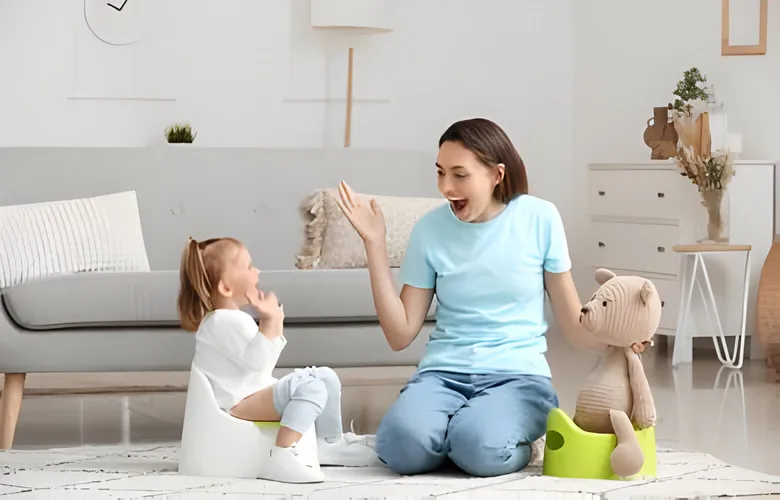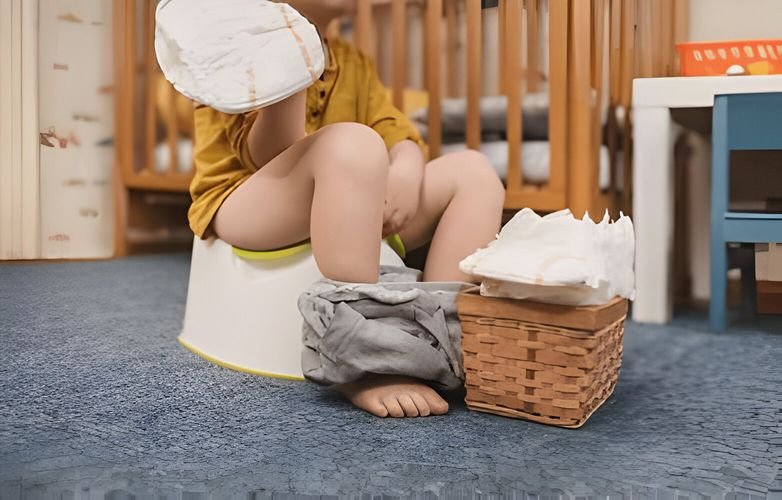
The 3-Day Potty-Training Method
The 3-Day Potty-Training Method

Are you thinking about giving the three-day potty-training method a shot? Before you dive into trying the three-day potty-training method, you might want to make sure your child is ready.
What is the three-day potty training method?
The three-day potty training method involves spending a solid weekend teaching your toddler how to use the potty. You’ll put everything else aside to focus on this, showing your little one the ropes, cheering on their every success, and encouraging them as they learn to ditch the diapers and start using the potty independently.
It’s a full-on approach and requires lots of parental involvement, but it works wonders for many, with significant progress often seen in just a few days. Before you dive in, make sure your toddler is up for it. Check that they can:
- Tell them when they need to go.
- Hold it for a few hours.
- Pull their pants up and down by themselves.
- Listen and follow basic instructions.
These are vital signs that they’re ready, making your three-day potty training much smoother and more successful.
A lot of parents like using what’s called the “bare bottom” technique. It’s simple: your kiddo skips wearing diapers or underwear during training. They might wear just a long shirt or loose pants, making getting to the potty fast and recognizing when to go easier. Whether you stick with this bare-bottom approach or opt for clothes that are easy to take off, the main thing is to keep things consistent, encourage, and stay tuned into what your child needs throughout the process.
The 3-Day Potty Training Challenge: How I Taught My Toddler
We felt it was time to start potty training our little one as she was overcoming her constipation and was about 28 months old (after a previous unsuccessful attempt at 18 – 20 months). We decided on the three-day method, planning to focus entirely over the weekend. Here’s what we did to get ready:
- We chose a bright and playful potty chair that we thought she would be excited to use.
- We opted for regular underwear right from the start, skipping over pull-ups to help her get used to them.
- We stocked up on small treats to keep the mood light and give her some incentive.
Before the weekend started, I began talking about the potty in a fun and engaging way to spark her interest.
First day: I hydrated my toddler with her usual 4-8 ounces of water. Knowing toddlers can have up to 16-32 ounces a day, but their bladders only hold about 3-5 ounces for a few hours. We were ready for plenty of trips to the bathroom and expected some accidents. It was tricky for her to grasp the process, and she occasionally needed clarification. I had a big stack of clean underwear ready, anticipating changes every 15 to 30 minutes, though sometimes she managed to go up to two hours. Yes, we had a lot of laundry to do! I stayed upbeat all day, encouraging her to make it to the potty in time and reminding her gently when it was time to try. Patience was key, and we celebrated every small success enthusiastically.
Second day: Things started to smooth out by the second day. My little one was improving at telling me when she needed to go and handling things more herself. We stuck with the routine we set on the first day, which helped her catch on quickly. I kept a close watch on how often she went, any little mishaps, and how much water she was drinking—I was hoping she could start to hold it for about two hours. I also checked the color and smell of her pee and cleaned her hands and bottom each time to avoid infections. She was heading to the potty about every hour, and even though there were a few accidents, there were fewer than the day before. Keeping to our routine mattered. I stayed calm and supportive every time she used the potty to keep the vibes positive, even if things didn’t go perfectly. I gave her little rewards like stickers and extra time for her favorite activities like painting and puzzles to make it fun and encouraging. These little treats helped her stay excited and eager to keep improving at using the potty.
Third day: By Day 3, we got into a rhythm. My little one told me on her own when she needed to go potty, and she could wait about an hour and a half to two hours between trips. We had a couple of accidents—just two or three during the day—but it was a big step up from the beginning.
I was there cheering her on for every successful potty visit, encouraging her. We kept doing her usual playing and activities, and even when she was really into her toys or crafts, she remembered to let me know when she needed to go. Her confidence was growing, and she was starting to do things by herself more. I kept reminding her to tell me when she needed to go potty throughout the day. It was essential to keep talking about it. This helped her learn this new skill and made sure she felt supported all the time. Consistently repeating this day after day helps it stick in their minds, building a routine that they recognize and follow.
After the 3-Day Potty Training: We kept everything upbeat and encouraging after our three-day potty training sprint, which was super important. We stuck close to home for those days to help our little one get the hang of things. By the fourth day, we felt ready to mix things up, so we decided to take a trip to the store. I reminded her before we left, “Honey, tell Mommy when you need to pee so we can get to the bathroom quickly.” My toddler did amazingly well—no accidents at all! She was great at letting me know when she needed a bathroom break, usually every couple of hours, depending on how much she drank.
We did have a few accidents, typically just once a day, when she was deep in her play or forgot to mention it. I kept regular reminders for her to use the potty, which only lasted about a week. Now, she’s doing fantastic and even heads to the potty alone!
How did we manage nighttime training?
It was quite a different chapter! First, we ensured she was comfortable using the potty during the day while continuing with diapers at night for a few more weeks. I often reminded her, “Remember, diapers are just like underwear, and we try not to pee in our underwear.” I hoped these words would sink in, making the concept second nature. Kids take words to heart after a while; my little one was no exception. Then, one beautiful morning, she woke up completely dry. I kept her in diapers at night just a bit longer to ensure she was ready. When her diapers consistently stayed dry, I knew she was prepared for the big move to nighttime underwear.
Now, what about training to poop in the potty?
Potty training for pooping has been so different from peeing! My little one has been a bit scared because it hurt before due to some tough times with constipation. I’ve ensured she eats plenty of high-fiber foods to make it easier. Sometimes, she refuses to sit or even try to poop, holding it in instead, which is challenging for both of us. She sometimes cries when it’s time to go, but she’s getting better each time. I always tell her, “It won’t hurt to sit and poop,” and I’m seeing her make progress. We’re taking this part of potty training super slowly and gently.
We’ve set up the training in easy steps and keep day and night training separate, which helps us manage. With lots of patience and continuous encouragement, I’m hopeful she’ll get as comfortable with pooping in the potty as she is with peeing. We’re taking it one step at a time, and I’m just so proud of how far she’s come!
Wrap-up: The three-day potty training method is only for some kids. I gave it a go when my little one was about 27-28 months old because she was ready to listen and follow what I said. If I had tried this when she was just 20 months old, I’m pretty sure it wouldn’t have worked. It’s perfect for tots who are good at following directions and interested in using the potty. This method also requires a lot from us parents—we must be super focused and ready to invest lots of time and energy. It’s a quick method that can overwhelm some kids; they might feel rushed or stressed. Watching your child closely during this time is crucial. It might be better to slow down or try a different approach to ensure a positive experience if it seems too harsh for them.






